Day 2: Just the Bare Necessity
Main Page >
2007 Stealing the Steel City
A bright Winter Morn, in Spring !!!
Waking up on a bright winter's morn the Boys felt
reasonable well from either drinking only the best beer in the world, Guinness,
their Primanti's Brothers Sandwich or combination of both.
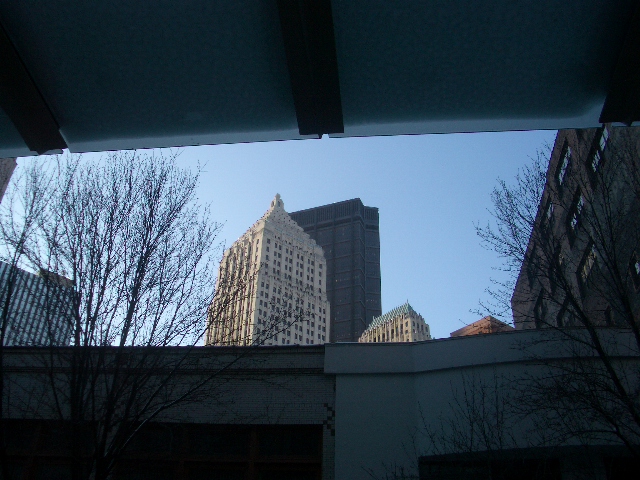
Wanting to break their fast they went to a 50's
Style Dinner in the Strip District. Having a couple of great omelet's and java,
they decided to take advantage of a half a day they had before headed out of
P-Town. Being a history buff and wanting to keep up the French and Indian War
motif, Bone had the necessity to see George Washington's Fort Necessity.
The Fort Necessity Story?"Rivals
in North America Rival claims between the French and the English to the vast
territory along the Ohio River between the Appalachian Mountains and the
Mississippi approached a climax about 1750. The Ohio Company (organized in 1748
by a group of prominent Englishmen and Virginians who saw the economic and
financial potential of the area) had obtained a large grant of 200,000 acres in
the upper Ohio River Valley. From its post at Wills Creek, now Cumberland,
Maryland, the Company planned additional settlements and started to open an
80-mile wagon road to the Monongahela River. Meanwhile, the French, who
considered the Ohio a vital link between New France (Canada) and Louisiana,
advanced southward and westward, from Fort Niagara on Lake Ontario, driving out
English traders and claiming the Ohio River Valley for France. In 1753, Governor
Robert Dinwiddie of Virginia learned the French had built Fort Presque Isle near
Lake Erie and Fort Le Boeuf in that part of the Ohio country claimed by
Virginia. He sent an eight-man expedition under George Washington to warn the
French to withdraw. Washington returned to Virginia and informed Governor Robert
Dinwiddie that the French refused to leave. In
January 1754, even before he learned of the French refusal to abandon the Ohio
Valley, Governor Dinwiddie sent a small force of Virginia soldiers to build a
fort at the forks of the Ohio, where Pittsburgh now stands. The stockade was
barely finished when a French force drove off the Virginians and built a larger
fort on the site. The French called it Fort Duquesne in honor of the Marquis de
Duquesne, the new governor of New France. In early April, George Washington ,
newly commissioned lieutenant colonel, started westward from Alexandria with
part of a regiment of Virginia frontiersmen to build a road to Redstone
Creek, present day Brownsville, Pennsylvania, on the Monongahela. He was then to
help defend the English fort on the Ohio. When Washington reached Wills Creek,
he learned the fort was in French hands. He resolved to push on to Redstone
Creek and await further instructions. By the end of May, his force was well
beyond Wills Creek when the commander of the expedition, Col. Joshua Fry,
arrived there with the rest of the Virginia Regiment.
By late May of 1754, Washington had reached a large natural
clearing known as the Great Meadows. He made this his base camp. Grass there
could provide food for his animals, and water was readily available.
Soon after he arrived, he received word that a party of French soldiers was
camped in a ravine not far from his position. On the stormy night of May 27th,
1754, Washington and about 40 men began an all night march to confront the
French and learn their intentions. They travelled through woods so dark the men
sometimes spent nearly half an hour just trying to find the trail. About dawn, Washington met with a friendly Seneca chief, Half
King, and made plans to contact the French Camp. As the French commander had not
posted sentries, Washington and his men easily surrounded the unsuspecting
French.
A shot was fired, no one really knows by whom, and soon the peaceful glen was
filled with the crash of musketry and the sulphurous smell of powder. The
skirmish lasted about 15 minutes. When it was over, 13 Frenchmen were dead and
21 captured. One escaped and made his way back to Fort Duquesne at the forks of
the Ohio. Washington's casualties were one man killed and two or three wounded.
Controversy surrounds the events that took place at Jumonville
Glen, named after Ensign Joseph Coulon de Jumonville. He was the leader of the
French detachment, and was killed there.
Soon after the smoke had cleared, French survivors claimed they had been
attacked without cause by Washington. They claimed they were on the same sort of
mission Washington himself had been on the winter before. That explained, they
said, why they had been so easily surprised and why they had not posted
sentries. Washington asked why, if the French were on a diplomatic mission, they
were hidden in a ravine, off the trail, and in the area for perhaps a couple of
days without approaching him.Washington sent his prisoners to Williamsburg while he
returned to the Great Meadows. After the skirmish with Jumonville's forces, Washington feared
"we might be attacked by considerable forces."He undertook to fortify his position at the Great Meadows.
During the last two days of May and the first three days of June, he built a
circular, palisaded fort, which he called Fort Necessity. He learned that Joshua Fry died at Will Creek on May 31.
Washington assumed command of the regiment and was promoted to colonel.The rest of the Virginia regiment arrived at the Great Meadows
on June 9, along with supplies and nine small cannon called swivel guns.
He was reinforced several days later by about 100 men of Capt. James
Mackay's Independent Company of regular British troops from South Carolina.
Washington's attempts to retain his Indian allies were not successful. While the South Carolinians remained at the Great Meadows,
Washington and his Virginians spent most of June opening a road from Fort
Necessity to Gist's Plantation, a frontier settlement in the direction of the
forks of the Ohio. Reports that a large force of French and Indians was
advancing from Fort Duquesne, however, caused him to withdraw his men to the
Great Meadows, where they arrived July 1.The next day, they strengthened Fort Necessity by improving
the trenches outside the stockade. On the morning of July 3, a force of about
600 French and 100 Indians approached the fort. After the French took up
positions in the woods, Washington withdrew his men to the entrenchments. Rain
fell throughout the day, flooding the marshy ground. Both sides suffered
casualties, but the British losses were greater than French and Indian losses. The fighting continued sporadically until about 8 p.m. Then
Capt. Louis Coulon de Villiers, commander of the French force and brother of
Jumonville, requested a truce to discuss the surrender of Washington's command. Near midnight, after several hours of negotiation,
Washington and Mackay signed the multi-part
document. The British were allowed to withdraw with the honors of war, retaining
their baggage and weapons, but having to surrender their swivel guns. Washington
surrendered his command to the French. One clause of stated that Washington was guilty of the
assassination of a French officer, Jumonville. He denied this. He said the
translation he had been given was not "assassination", but "death of" or
"killing." In any event, the French used this propaganda to great advantage in
efforts to discredit the English.
It is way too cold to check out the stockade !!
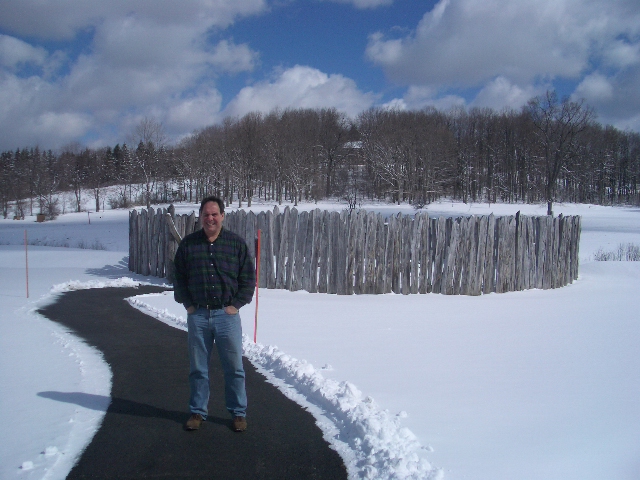
With this story in hand the Boys descended onto
Fort Necessity an hour later than they planned to, which necessitated a "speed
tour" of Fort Necessity. Despite the lack of time, the 20 degree cod
weather, and the blustery winds the Boys did notice that the "Fort" was poorly
positioned at the bottom of three different hills, which would give any enemy
the opportunity to choose their location to shoot down into the stockade.
Apparently young George hadn't hear the term, location, location, location !! After 20 minutes the Boys had to boogie back
toward the city when they came unexpectedly across the Tomb of General Braddock.General Braddock's Secret Grave !?!?
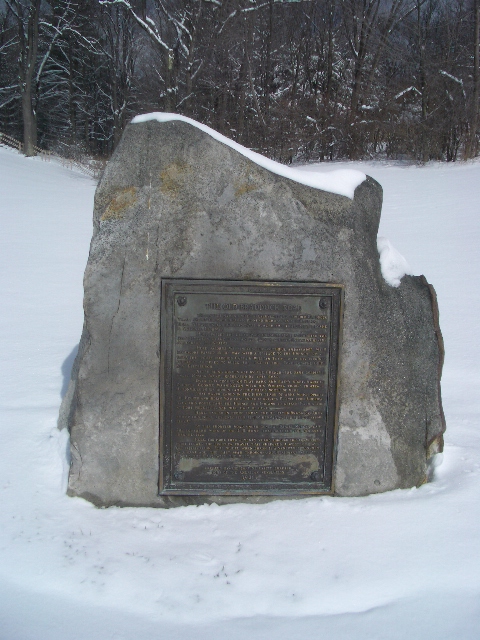
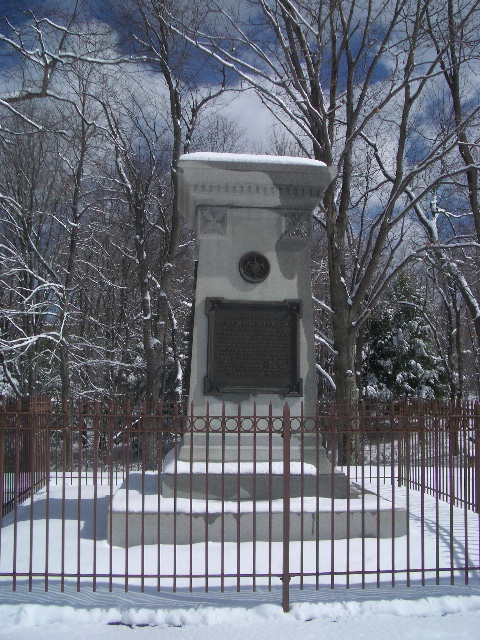
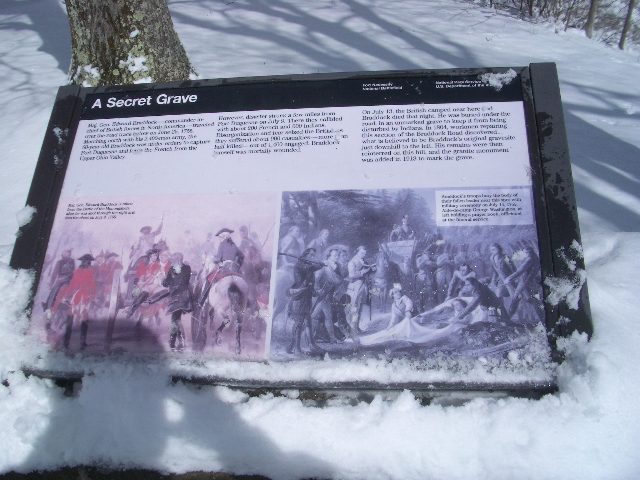
In 1755, one year after Washington's
defeat at Fort Necessity and the start of the French and Indian War, the British
were resolved to eliminate the French from North America. British officer Major
General Edward Braddock was selected to lead the campaign. Braddock personally
commanded a regimen to attack the French at Fort Duquesne, located at present
day Pittsburgh. Washington accompanied Braddock as an aide. On July 9, 1755,
while the expedition was enroute to Fort Dusquesne, the British were surprised
by French and Indian forces which totally overwhelmed the British contingent.
The elite British force suffered horrendous losses and were forced to retreat.
Although Braddock had been schooled in the art of Warfare in England, his
tactics were no match for the French and their Indian allies. Braddock himself
was among the severely wounded. On their retreat on July 13, the British camped
about one mile west of the former Fort Necessity when Braddock succumbed to his
injuries.
After dark of the day
General Braddock died (July 13th), Col. Washington buried the body in the
middle of the army's road and had the troops march over it the next day.
This was to hide the remains from the scavenging Indians who would want to
plunder the grave and
desecrate the remains. The army then continued its retreat on to
eastern Pennsylvania. In 1832 workmen were repairing the
now National Road
they discovered Gen. Braddock's grave. His remains were removed from the road site and placed in a well marked grave on a knoll above the original
site. Mike and Bone snapped two quick shots due to the cold and
the time.
Trip, Postscript
After visiting Braddock Grave, the Boys hightailed it back to
the Pittsburgh Airport with a belly full of Dirty O' hotdogs, Primanti's Brothers
sandwiches, Guinness, Bushmills, French and Indian War stories, as well as a few
of their own.





